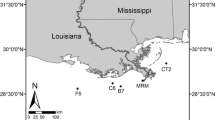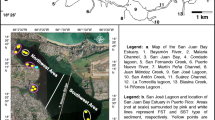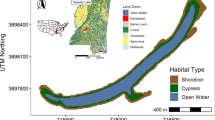Abstract
The capacity of a lake to remove reactive nitrogen (N) through denitrification has important implications both for the lake and for downstream ecosystems. In large oligotropic lakes such as Lake Superior, where nitrate (NO3 −) concentrations have increased steadily over the past century, deep oxygen penetration into sediments may limit the denitrification rates. We tested the hypothesis that the position of the redox gradient in lake sediments affects denitrification by measuring net N-fluxes across the sediment–water interface for intact sediment cores collected across a range of sediment oxycline values from nearshore and offshore sites in Lake Superior, as well as sites in Lake Huron and Lake Erie. Across this redox gradient, as the thickness of the oxygenated sediment layer increased from Lake Erie to Lake Superior, fluxes of NH4 + and N2 out of the sediment decreased, and sediments shifted from a net sink to a net source of NO3 −. Denitrification of NO3 − from overlying water decreased with thickness of the oxygenated sediment layer. Our results indicate that, unlike sediments from Lake Erie and Lake Huron, Lake Superior sediments do not remove significant amounts of water column NO3 − through denitrification, likely as a result of the thick oxygenated sediment layer.







Similar content being viewed by others
References
Anthony, J. L. & W. M. Lewis, Jr., 2012. Low boundary layer response and temperature dependence of nitrogen and phosphorus releases from oxic sediments of an oligotrophic lake. Aquatic Sciences – Research Across Boundaries 74(3): 611–617.
Bennett, E., 1978. Characteristics of the thermal regime of Lake Superior. Journal of Great Lakes Research 4: 310–319.
Finlay, J. C., R. W. Sterner & S. Kumar, 2007. Isotopic evidence for in-lake production of accumulating nitrate in Lake Superior. Ecological Applications 17: 2323–2332.
Galloway, J. N., 1998. The global nitrogen cycle: changes and consequences. Environmental Pollution 102: 15–24.
Galloway, J. N., F. J. Dentener, D. G. Capone, E. W. Boyer, R. W. Howarth, S. P. Seitzinger, G. P. Asner, C. C. Cleveland, P. A. Green, E. A. Holland, D. M. Karl, A. F. Michaels, J. H. Porter, A. R. Townsend & C. J. Vorosmarty, 2004. Nitrogen cycles: past, present, and future. Biogeochemistry 70: 153–226.
Gardner, W. S., T. F. Nalepa & J. M. Malczyk, 1987. Nitrogen mineralization and denitrification in Lake Michigan sediments. Limnology & Oceanography 32: 1226–1238.
Heinen, E. A. & J. McManus, 2004. Carbon and nutrient cycling at the sediment-water boundary in western Lake Superior. Journal of Great Lakes Research 30: 113–132.
Joye, S. B. & J. T. Hollibaugh, 1995. Influence of sulfide inhibition of nitrification on nitrogen regeneration in sediments. Science 270: 623–625.
Kling, G. W., G. W. Kipphut & M. C. Miller, 1992. The flux of CO2 and CH4 from lakes and rivers in Arctic Alaska. Hydrobiologia 240: 23–36.
Klump, J., R. Paddock, C. C. Remsen, S. Fitzgerald, M. Boraas & P. Anderson, 1989. Variations in sediment accumulation rates and the flux of labile organic matter in eastern Lake Superior basins. Journal of Great Lakes Research 15: 104–122.
Kumar, S., R. S. Sterner & J. C. Finlay, 2008. Nitrogen uptake dynamics in Lake Superior. Journal of Geophysical Research: Biogeosciences 113: G04003.
Li, J., S. A. Rowe, D. Miklesh, M. Kistner, D. E. Canfield & S. Katsev, 2012. Carbon mineralization and oxygen dynamics in sediments with deep oxygen penetration, Lake Superior. Limnology & Oceanography 57: 1634–1650.
Matheson, D. H. & M. Munawar, 1978. Lake Superior basin and its development. Journal of Great Lakes Research 4: 249–263.
Munawar, M. & I. F. Munawar, 1978. Phytoplankton of Lake Superior 1973. Journal of Great Lakes Research 4: 415–442.
Nielson, L. P., 1992. Denitrification in sediments determined from nitrogen isotope pairing. FEMS Microbiology Ecology 86: 357–362.
Pfenning, K. S. & P. B. McMahon, 1996. Effect of nitrate, organic carbon, and temperature on potential denitrification rates in nitrate-rich riverbed sediments. Journal of Hydrology 187: 283–295.
Redfield, A., 1958. The biological control of chemical factors in the environment. American Scientist 46: 205–221.
Revsbech, N. P., 1989. An oxygen microelectrode with a guard cathode. Limnology & Oceanography 34: 472–476.
Risgaard-Petersen, N., L. P. Nielsen, S. Rysgaard, T. Dalsgaard & R. L. Meyer, 2003. Application of the isotope pairing technique in sediments where anammox and denitrification coexist. Limnology & Oceanography: Methods 1: 67–73.
Robertson, D. M., 1997. Regionalized loads of sediment and phosphorus to Lakes Michigan and Superior – high flow and long-term averages. Journal of Great Lakes Research 23: 416–439.
Seitzinger, S. P., 1988. Denitrification in freshwater and coastal marine ecosystems: ecological and geochemical significance. Limnology & Oceanography 33: 702–724.
Seitzinger, S., J. A. Harrison, J. K. Böhlke, A. F. Bouwman, R. Lowrance, B. Peterson, C. Tobias & G. Van Drecht, 2006. Denitrification across landscapes and waterscapes: a synthesis. Ecological Applications 16: 2064–2090.
Small, G. E., G. S. Bullerjahn, R. W. Sterner, B. F. N. Beall, S. Brovold, J. C. Finlay, R. M. L. McKay & M. Mukherjee, 2013. Rates and controls of nitrification in a large oligotrophic lake. Limnology & Oceanography 58: 276–286.
Sterner, R. W., 2011. C:N:P stoichiometry in Lake Superior: freshwater sea as end member. Inland Waters 1: 29–46.
Sterner, R. W., T. M. Smutka, R. M. L. McKay, Q. Xiaoming, E. T. Brown & R. M. Sherrell, 2004. Phosphorus and trace metal limitation of algae and bacteria in Lake Superior. Limnology & Oceanography 49: 495–507.
Sterner, R. W., E. Anagnostou, S. Brovold, G. S. Bullerjahn, J. C. Finlay, S. Kumar, R. M. L. McKay & R. M. Sherrell, 2007. Increasing stoichiometric imbalance in North America’s largest lake: nitrification in Lake Superior. Geophysical Research Letters 34: L10406.
Taylor, B. W., C. A. Keep, A. S. Flecker, R. O. Hall, B. J. Koch, L. M. Tronstad & A. J. Ulseth, 2007. Improving the fluorometric ammonium method: matrix effects, background fluorescence, and standard additions. Journal of the North American Benthological Society 26: 167–177.
Thomas, R. L. & C. I. Dell, 1978. Sediments of Lake Superior. Journal of Great Lakes Research 4: 264–275.
Vitousek, P. M., J. D. Aber, R. W. Howarth, G. E. Likens, P. A. Matson, D. W. Schindler, W. H. Schlesinger & D. G. Tilman, 1997. Human alteration of the global nitrogen cycle: sources and consequences. Ecological Applications 7: 737–750.
Acknowledgments
We thank the crew of the R/V Blue Heron for their support during this study. This research was supported by the National Science Foundation under NSF grant OCE-0927512. Sediment O2 profiles from 2010 were measured by Sergei Katsev and Jiying Li. Kurt Spokas analyzed N2O and CO2 samples. Holly Meier contributed to the potential nitrification measurements. We acknowledge the suggestions of two anonymous reviewers in helping to improve the manuscript.
Author information
Authors and Affiliations
Corresponding author
Additional information
Guest editors: D. Straile, D. Gerdeaux, D. M. Livingstone, P. Nõges, F. Peeters & K.-O. Rothhaupt / European Large Lakes III. Large lakes under changing environmental conditions
Rights and permissions
About this article
Cite this article
Small, G.E., Cotner, J.B., Finlay, J.C. et al. Nitrogen transformations at the sediment–water interface across redox gradients in the Laurentian Great Lakes. Hydrobiologia 731, 95–108 (2014). https://doi.org/10.1007/s10750-013-1569-7
Received:
Accepted:
Published:
Issue Date:
DOI: https://doi.org/10.1007/s10750-013-1569-7




